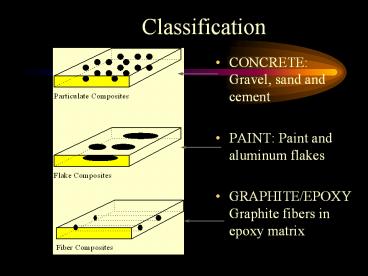Classification - PowerPoint PPT Presentation
1 / 27
Title:
Classification
Description:
Classification CONCRETE: Gravel, sand and cement PAINT: Paint and aluminum flakes GRAPHITE/EPOXYGraphite fibers in epoxy matrix Polymer Matrix Composites What are the ... – PowerPoint PPT presentation
Number of Views:135
Avg rating:3.0/5.0
Title: Classification
1
Classification
- CONCRETE Gravel, sand and cement
- PAINT Paint and aluminum flakes
- GRAPHITE/EPOXYGraphite fibers in epoxy matrix
2
Polymer Matrix Composites
- What are the most common advanced composites?
- Graphite/Epoxy
- Kevlar/Epoxy
- Boron/Epoxy
3
Polymer Matrix Composites
- What are the drawbacks of polymer matrix
composites? - Low operating temperatures
- High CTE and CMEs
- Low elastic properties in certian directions
4
Are Carbon and Graphite the Same?
- No
- Carbon fibers have 93-95 carbon content and
graphite has gt99 carbon content - Carbon fibers are produced at 2400o F and
graphite fibers are produced at 3400o F
5
Table 1.4. Typical mechanical properties of
polymer matrix composites and monolithic materials
6
Comparative Stiffness of PMCs and Metals
7
How to make a PMC
8
Schematic of Prepreg Manufacturing
9
Prepreg Boron/Epoxy
10
Autoclave Lamination
11
Filament Winding
12
Resin Transfer Molding
13
Common PMC Fibers Matrices
- Fibers
- Graphite
- Glass
- Kevlar
- Matrices
- Epoxy
- Phenolic
- Polyester
14
Table 1.5 Typical mechanical properties of
fibers used in polymer matrix composites
15
Cost Comparison of PMC fibers
- Type of fiber Cost ( per pound)
- A-glass .65 - .90
- C-glass .75 - 1.00
- E-glass .75 - 1.00
- S-2 Glass 6.00 - 8.00
- Heavy Tow 9.00 - 12.00
- Medium Tow 15.00 -20.00
- Low Tow 40.00 -70.00
- Kev29 12.00 -14.00
- Kev149 25.00 -30.00
16
Manufacturing of Glass Fibers
17
Glass Fiber Types
- E-glass (fiberglass) - electrical applications
- S-glass - strength applications
- C-glass - Corrosion resistant
- D-glass - Low dielectric applications
- A-glass - Appearance applications
- AR-glass - Alkali resistant
18
Table 1.6 Comparison of properties of E-glass
and S-glass
19
Table 1.7 Chemical Composition of E-Glass and
S-glass Fibers
20
Fig 1.10 Forms of Fibers
21
Fig 1.11 Manufacturing Graphite Fibers
22
Resin Systems
- Polyester
- Phenolics
- Epoxy
- Silicone
- Polymide
23
Properties of epoxy
24
Curing Stages of Epoxy
25
Comparison of Resins
26
Difference between thermosets and thermoplastics
27
Pre-Preg Graphite/Epoxy































